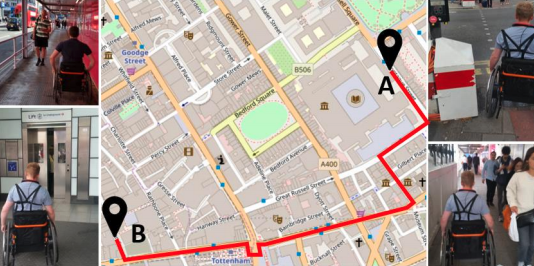There are over 1.2 million wheelchair users in the United Kingdom. And the number is set to rise in line with a growing and ageing population. Many wheelchair users face a variety of stressors of navigating in a city, such as crowdedness, potholes, temporary constructions [2,3]. It has shown that such barriers lead to anxiety, frustration, and fear of travelling. To address some part of this challenge, the UCL team has been developing a proof-of-concept mapping interface for crowdsourcing stress of wheelchair users when navigating. This incorporates two state-of-the-art technologies: i) geomatic environmental mapping that mainly uses GPS and an inertial measuring unit to accurately estimate a user’s location, wheelchair wheeling, and ambient information of a route taken [2,3], ii) physiological computing that automatically assesses a user’s mental stress through physiological monitoring [1,4-6]. At this initial stage, the team has been investigating ways to ensure a high level of comfort and compactness of the interface for wheelchair users’ daily navigation.
References
[1] Cho, Y., Julier, S. J. and Bianchi-Berthouze, N., 2019. Instant Stress: Detection of Perceived Mental Stress Through Smartphone Photoplethysmography and Thermal Imaging. JMIR mental health, 6(4), e10140.
[2] Cho, Y., Bianchi-Berthouze, N., Marquardt, N. and Julier, S.J., 2018. Deep thermal imaging: Proximate material type recognition in the wild through deep learning of spatial surface temperature patterns. In Proceedings of the 2018 CHI Conference on Human Factors in Computing Systems, pp. 1-13.
[3] Herrera, R. R., Holloway, C., Ramirez, D. Z. M., Zhang, B. and Cho, Y., 2020. Breathing Biofeedback Relaxation Intervention for Wheelchair Users in City Navigation. In 2020 42nd Annual International Conference of the IEEE Engineering in Medicine & Biology Society (EMBC), pp. 4575-4578.
[4] Cho, Y., Julier, S.J., Marquardt, N. and Bianchi-Berthouze, N., 2017. Robust tracking of respiratory rate in high-dynamic range scenes using mobile thermal imaging. Biomedical optics express, 8(10), pp.4480-4503.
[5] Cho, Y., Bianchi-Berthouze, N. and Julier, S.J., 2017. DeepBreath: Deep learning of breathing patterns for automatic stress recognition using low-cost thermal imaging in unconstrained settings. In 2017 Seventh International Conference on Affective Computing and Intelligent Interaction (ACII), pp. 456-463.
[6] Cho, Y., Kim, S. and Joung, M., 2017. Proximity sensor and control method thereof. U.S. Patent 9,703,368.
